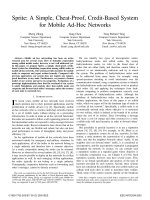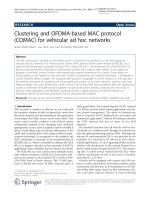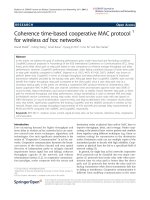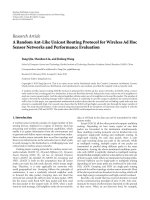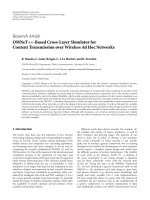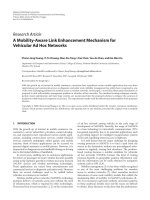security for wireless ad hoc networks
Bạn đang xem bản rút gọn của tài liệu. Xem và tải ngay bản đầy đủ của tài liệu tại đây (4.22 MB, 266 trang )
www.sharexxx.net - free books & magazines
SECURITY FOR WIRELESS
AD HOC NETWORKS
Farooq Anjum and Petros Mouchtaris
SECURITY FOR WIRELESS
AD HOC NETWORKSSECURITY FOR WIRELESS
AD HOC NETWORKS
Farooq Anjum and Petros Mouchtaris
Wiley Bicentennial Logo: Richard J. Pacifico
Copyright # 2007 by John Wiley & Sons, Inc. All rights reserved
Published by John Wiley & Sons, Inc., Hoboken, New Jersey
Published simultaneously in Canada.
No part of this publication may be reproduced, stored in a retrieval system, or transmitted in any form or by
any means, electronic, mechanical, photocopying, recording, scanning, or otherwise, except as permitted
under Section 107 or 108 of the 1976 United States Copyright Act, without either the prior written
permission of the Publisher, or authorization through payment of the appropriate per-copy fee to the
Copyright Clearance Center, Inc., 222 Rosewood Drive, Danvers, MA 01923, (978) 750-8400, fax (978)
750-4470, or on the web at www.copyright.com. Requests to the Publisher for permission should be
addressed to the Permissions Department, John Wiley & Sons, Inc., 111 River Street, Hoboken,
NJ 07030, (201) 748-6011, fax (201) 748-6008, or online at />Limit of Liability/Disclaimer of Warranty: While the publisher and author have used their best efforts in
preparing this book, they make no representations or warranties with respect to the accuracy or
completeness of the contents of this book and specifically disclaim any implied warranties of merchantability
or fitness for a particular purpose. No warranty may be created or extended by sales representatives or
written sales materials. The advice and strategies contained herein may not be suitable for your situation.
You should consult with a professional where appropriate. Neither the publisher nor author shall be liable
for any loss of profit or any other commercial damages, including but not limited to special, incidental,
consequential, or other damages.
For general information on our other products and services or for technical support, please contact our
Customer Care Department within the United States at (800) 762-2974, outside the United States at
(317) 572-3993 or fax (317) 572-4002.
Wiley also publishes its books in a variety of electronic formats. Some content that appears in print may
not be available in electronic formats. For more information about Wiley products, visit our web site at
www.wiley.com.
Library of Congress Cataloging-in-Publication Data:
Anjum, Farooq.
Security for wireless ad hoc networks / by Farooq Anjum & Petros Mouchtaris.
p. cm.
Includes bibliographical references and index.
ISBN: 978-0-471-75688-0
1. Wireless LANs - - Security measures. I. Mouchtaris, Petros. II. Title
TK5105. 59. A54 2007
005.8- -dc22 2006029342
Printed in the United States of America
10987654321
Dedicated to:
My parents
(F. A.)
My late father
(P. M.)
CONTENTS
Preface xi
Foreword xiii
Acknowledgments xv
1 Introduction 1
1.1 Definition of Wireless Ad Hoc Networks 1
1.2 Applications of Wireless Ad Hoc Networks 5
1.3 Threats, Attacks, and Vulner abilities 7
1.3.1 Threats 8
1.3.2 Vulnerabilities in Ad Hoc Networks 9
1.3.3 Attacks 10
1.4 Overview of the Book 13
2 Basic Security Concepts 15
2.1 Introduction 15
2.2 Basic Concepts 16
2.2.1 Attributes 16
2.2.2 Cryptographic Primitives 18
2.3 Modes of Operation 30
2.4 Miscellaneous Properties 34
2.4.1 One-Way Property of Hash Chains 35
2.4.2 TESLA 35
2.5 Summary 38
3 Key Management 39
3.1 Introduction 39
3.2 Traditional Solution 40
3.3 Solutions for Ad Hoc Networks 44
3.3.1 Asymmetric Key-Based Approach 44
3.3.2 Symmetric Key-Based Approach 49
3.4 Summary 68
vii
4 Secure Routing 69
4.1 Introduction 69
4.1.1 Distance-Vector and Link-State Routing 69
4.1.2 Proactive vs Reactive Routing 70
4.2 Ad Hoc On-Demand Distance Vector 72
4.2.1 Secure AODV 73
4.2.2 Authenticated Routing for Ad Hoc
Networks (ARAN) 77
4.2.3 Security-Aware Ad Hoc Routing 79
4.3 Dynamic Source Routing Protocol 80
4.3.1 Secure Routing Protocol 81
4.3.2 Ariadne 84
4.3.3 EndairA: A Provably Secure Routing Protocol 90
4.4 Destination-Sequenced Distance-Vector Routing Protocol 91
4.4.1 Secure Efficient Distance Vector Routing (SEAD) 92
4.4.2 SuperSEAD 95
4.4.3 S-DSDV 98
4.5 Optimized Link-State Routing Protocol 99
4.5.1 Secure Extension to OLSR 101
4.5.2 Secure Link-State Routing Protocol 103
4.6 Anonymous Routing Protocols 105
4.6.1 ANODR 106
4.6.2 MASK 109
4.7 Generic Attacks Against Routing 113
4.7.1 Wormhole Attacks 113
4.7.2 Rushing Attacks 117
4.7.3 Sybil Attacks 118
4.8 Summary 119
5 Intrusion Detection Systems 120
5.1 Introduction 120
5.1.1 Traditional IDS Systems 121
5.2 Unique IDS Challenges in MANET 126
5.3 Threat Model 127
5.4 Architecture for Intrusion Detection in MANET 129
5.4.1 Noncollaborative Intrusion Detection System 131
5.4.2 Cooperative Intrusion Detection 135
5.4.3 Key Novel Concepts for Cooperative Intrusion
Detection in MANET 140
viii CONTENTS
5.5 Evidence Collection 148
5.5.1 Local Evidence 148
5.5.2 Promiscuous Monitoring 149
5.5.3 Evidence made Availabl e by Other Nodes 150
5.6 Detection of Specific Attacks 151
5.6.1 Detection of Packet Dropping Attacks 151
5.6.2 Detection of Attacks Against Routing Protocols 155
5.7 Summary 159
6 Policy Management 160
6.1 Introduction 160
6.2 Policy-Based Network Management 162
6.2.1 Overview 162
6.2.2 Architecture 163
6.2.3 Policy Languages 165
6.2.4 Distributed Policy Management Architecture 170
6.2.5 IETF and DMTF Standardization Activities 176
6.3 Application of Policy Management to Security
Management 178
6.3.1 Role-Based Access Control (RBAC) 178
6.3.2 Trust Management and the KeyNote System 178
6.3.3 Firewall Management 180
6.3.4 Policy Enforcement in a Wireless Ad Hoc Network 181
6.4 Summary 183
7 Secure Localization 185
7.1 Introduction 185
7.2 Localization 187
7.2.1 Ranging 189
7.2.2 Computation 199
7.2.3 Attacks 202
7.3 Secure Localization 203
7.3.1 Distance Bounding Techni ques 204
7.3.2 Verifiable Multilaterat ion 208
7.3.3 Directional Antennae-Based Schemes 211
7.3.4 Transmission Range Variation-Based Schemes 216
7.3.5 Hybrid Schemes 220
7.3.6 Malicious Beacons 221
7.4 Summary 223
CONTENTS ix
8 Conclusions and Future Research 224
8.1 Vehicular Networks 225
8.1.1 Differences with MANET 227
8.1.2 Open Problems and Solutions 228
8.2 Summary 230
Acronyms 231
References 234
Index 245
x CONTENTS
PREFACE
Wireless networks, whether cellular networks or wireless local area networks (LANs),
have rapidly become an indispensable part of our life. Evidence of this is the widespread
usage of such networks in several areas such as office, home, universities, hot-spots such
as airports and hotels etc. In addition, the widespread availability of miniature wireless
devices such as PDAs, cellular phones, Pocket PCs, and small fixtures on buildings,
sensors are one step towards making possible the vision of wireless ‘nirvana’ a reality.
Wireless ‘nirvana’ is the state of seamless wireless operation where any wirel ess device
would be able to connect to any other wireless device or network at any time, in any
place while satisfying the requirements of the user of the device. But as is obvious, we
are still a long way off from the goal of wireless nirvana.
Technology under development for wireless ad hoc networks is enabling our march
toward this end goal; however the security concerns in wireless networking remains a
serious impediment to widespread adoption. The underlying radio communication
medium for wireless networks is a big vulnerability that can be exploited to launch
several attacks against wireless networks. In addition, wireless ad hoc networks usually
cannot depend on traditional infrastructure found in enterprise environments such as
dependable power sources, high bandwidth, continuous connectivity, common network
services, well-known membership, static configuration, system administration, and phys-
ical security. Without adequate security, enterprises will shy away from the use of wireless
ad hoc networks, governmental agencies will ban the use of wireless ad hoc networks,
defense organizations might be unable to guarantee the safety of their personnel in battle-
field scenarios and users will be liable for actions that they never committed.
Therefore, security of such wireless ad hoc networks is an important area that needs to
be addressed if such networks are to be widely used. There are two way s of doing this.
One way is for the researchers in this field to identify open problems and provide solutions
to the identified open problems. Each such effort makes these wireless networks a little bit
more secure. There have been several research efforts in the last couple of years exploring
ways of making such networks more secure although much more work still needs to be
done. We ourselves have also been engaged in this activity.
The second way to address the security issues of such networks is to disseminate widely
the known results to the beginners in this field. This will allow more people to comprehend
the problems and contribute towards expanding the knowledge in this area. Unfortunately
there has not been any work done along these lines. Our effort in this book is focused on
this approach of dissemination of known knowledge in the area of secur ity in wireless
ad hoc networks.
To our knowledge, this book is the first book that focuses exclusively on the topic of
security for wireless ad hoc networks. The topic of security in wireless ad hoc networks
itself is very vast. This topic spans areas such as securing networking protocols, operating
systems on mobile devices, and applications etc. In this book we focus on the topic of
xi
securing network prot ocols in wireless ad hoc networks. Note that networking in ad hoc
networks is concerned with enabling two devices with wireless interfaces to communicate
with each other.
The objective of this book is to make the readers aware of the fundamentals of the area
of security of wireless networks as well as the open problems. This will hopefully spur
much more activity in this area in the upcoming years. This book provides a broad and
comprehensive overview of the research that has been done to date on the security of wire-
less ad hoc networks and discusses the advantages and disadvantages of the various
schemes that have been proposed in the literature.
Given the objective of this book, it is necessary to write it in a style that does not assume
a detailed knowledge of many concepts. Therefor e, in writing this book, the only require-
ment that we assumed from the reader is a basic understanding of networking concepts.
Given this, we explain the concepts of wireless ad hoc networks at a fairly basic level.
We also require limited knowledge of security concepts from the reader. We provide a
chapter that introduces the basic security concepts that are required for the rest of the book.
This book will be of int erest to a wide variety of people. A beginner in the field will
benefit from a simple description of the various problems and solutions. Such a person
will also gain by having a ready compendi um of important results in this area thereby
saving such a person from the problem of information overload. Thus, this book can be
used as a textbook in the first class focusing on security in ad hoc networks.
Researchers focusing on wireles s networks that would like to consider the security
implications of the protocols they are designing would benefit from a description of
known problems and solutions to these known problems. Additionally, researchers focus-
ing on novel security schemes for wireless ad hoc networks that would like to become
aware of existing research should also profit from the description of various schemes in
this book. This will let them know about what is out there and what is needed. Finally,
this should also be a valuable book for researchers focusing on applications of wireless
ad hoc networks in a commercial or military environment. All these groups comprise
the intended audience of the book.
Of course, we do not expect this effort to be perfect. Errors might have crept in; some
other topics that you, the reader, feel are important might have been left out. In some cases,
our comments on the problems and their solutions would have been biased due to our
backgrounds. There will be other ways also in which the book could be improved. We
would like to hear from you, the reader, on each of these aspects. Therefore, feel free
to write to us on these or any other topic that you feel is relevant to the book. And if
you enjoyed reading the book, we would like to hear about that also. We also have a
blog at where such errata or our responses to
your comments will be provided. This title can be accessed at the following FTP site:
/>In the meantime, happy reading.
Farooq Anjum Petros Mouchtaris
xii PREFACE
FOREWORD
Rapid and automatic establishment of wireless networks and services in the absence of a
fixed infrastructure is one of the big challenges of communication. The complexity of the
problem is greatly compounded when the nodes of the network have to accommodate
rapid and unpredictable motion, dynamically altering the connectivity of the network
itself. The attractiveness and value of such ‘ad hoc networks’ rests on their ability to
meet performance parameters hard to achieve otherwise and to do so while optimizing
the use of resources such as spectrum, energy, and opera tions support functions at
scale. A final dimension of this multidisciplinary problem is the achievement of a solution
which in some sense minimi zes the probability of disruption from natural and malicious
threats and at the same time maximizes availability assuring authorized users access to
critical services. This book captures the current state of the art in wireless ad hoc networks
with an emphasis on security and assurance.
In the last decade researchers have explored many potential applications of wireless ad
hoc networ ks. The research has ranged from basic theoretical investigations to prototypes
and demonst rations. The largest body of work has been in the government arena.
The Department of Defense has invested seriously in exploiting wireless ad hoc networks
in its transformational programs. Telcordia has been at the forefront of both creating new
network technologies and exploring newer approaches for securing such networ ks. This
has involved leveraging ideas from basic science to propose engineering principles
for designing and deploying such networks. It has also involved construction of proof-
of-principle testbeds, prototypes, demonstrations, and the steps necessary to transition
the technology to general use. While there are many problems still to be solved, it has
been gratifying to see the technology move from a concept to reality. Over this span of
time there has been stalwart support for these efforts from agencies such as the Army
Research Lab (ARL), the Army Communications Electronics Research, Development
and Engineering Center (CERDEC), and DARPA. On the commercial and public sector
front the technology has been developing more slowly but is finding its way into many
applications. These include transportation networks, emergency response, law enforce-
ment, and sensor systems. Perhaps the greatest use of this technology will be to fill the
gap in fixed infrastructure which will allow public wireless systems to really achieve
the goal of delivering applications to any place through hybrid networks of cellular and
ad hoc components.
In performing the research which is codified in this book, one of the ingredients that the
authors bring to the table is the knowledge and intuition of ‘real’ communications systems
and applications. In a commercial setting with clients who are used to hardened products
that affect a large customer base the non-functional attributes of solutions are just as
important as the functional aspects. The delivery of a service over a network can som e-
times be demonstrated easily. When the require ment is to build it out at scale with high
reliability and availability and with a high degree of security what may seem as an easy
xiii
problem suddenly becomes hard. One of the values of this book is to expose the reader
to such issues in an expository and complete way indicating the parts of the problem
that have been solved and the parts that still require further investigation.
In closing I would like to commend both Petros Mouchtaris and Farooq Anjum for the
professionalism and dedication they have shown in writing this book. They both have
highly demanding jobs, so this task took a lot of extra effort. I hope that they get positive
feedback and feel the satisfaction they deserve for the excellent job they have done in
collecting, codifying, and explaining the advanced material that comprises this important
book.
Adam Drobot
President,
Applied Research
Telcordia Technologies
xiv FOREWORD
ACKNOWLEDGME NTS
We would like to start by thanking the management of Telcordia who made it possible
for us to not only entertain the idea of writing this book, but also executing the idea.
Showstopper issues such as copyright were addressed very efficiently which again was
due to the ‘Telcordia’ culture. We would like to thank in particular the president of
Applied Research, Adam Drobot, who encouraged us to pursue writing this book.
The book itself would not have been possible if not for the efforts of the various people
working in this field. These people not only identified the problems in this area but also
provided solutions to such problems. In this bo ok, we tried to identify various interesting
research problems in the field and discuss approaches that have been pursued by various
researchers. Names of such people are scattered all over the book in the form of references
to their works that we explain in each of the chapters.
We also benefited much from comments on the various chapters of the book provided
by various people working in this area. We are very grateful to Srdjan Capkun, Peng Ning,
Adrian Perrig, Santosh Pandey, Rajesh Talpade, Ritu Chadha and Mike Little for their
comments which resulted in a better manuscript.
Writing a book is never easy especially on the families of the authors. The hours of
sacrifice needed on the part of the spouses and also their efforts to ensure that the
authors are in the right frame of mind is something that we are sure every author appreci-
ates and cannot put a cost to. On this front, the first author is very thankful to Ambareen
while the second author is very than kful to Donna.
We are also very thankful to the team at John Wiley who made the entire process as
painless as possible to us. We would be failing if we do not mention Whitney Lesch
who was in constant touch with us to address any questions we had about the book.
xv
1 Introduction
1.1 DEFINITION OF WIRELESS AD HOC NETWORKS
In the last few years we have seen the proliferation of wireless communications
technologies. Wireless technologie s are being widely used today across the globe to
support the communications needs of very large numbers of end users. There are over 1
billion wireless subscribers of cellular services today utilizing wireless devices for
voice communications (e.g. phone calls) and data services. Data services include activities
such as sending e-mail and instant messages, and accessing the Web. In fact, in some areas
of the world wireless technologies are more prevalent than traditional wireline
communications technologies.
There are several reasons for the current popularity of wireless technologies. The cost
of wireless equipment has dropped significantly, allowing service providers to
significantly reduce the price of wireless services and making them much more affordable
to end users. The cost of installing wireless networks in emerging markets has dropped
well below the cost of installing wireline networks. The wireless technologies themselves
have improved tremendously, making it possible to offer both voice and data services over
such networks. The resulting allure of anytime, anywhere services makes such services
very attractive for the end users.
In wireless networks, nodes transmit information through electromagnetic propagation
over the air. The signal transmitted by a node can only be received by nodes that are located
within a specific distance from the transmitting node. This distance is typically called the
transmission range. The transmission range depends not only on the power level used for
the transmission, but also on the terrain, obstacles, and the specific scheme used for
transmitting the informat ion. Typically, for simplicity, the transmission range of nodes
is assumed to be a circle around the transmitting node, as shown in Figure 1.1.
Typically multiple nodes exist within an area and these nodes might need to make use
of the wireless med ium for communication. If many such transmissions happen at the
same time within the transmission range of a node, then this will result in the transmissions
colliding with each other. Such collisions make it impossible for receivers to interpret the
data being transmitted by individual nodes. The effect here is similar to many people
talking simultaneously to a person, in which case the person involved will not be able
to understand any of them. Therefore, it is vital to prevent or minimize such collisions.
This can be done by controlling access to the wireless medium. This is the approach
typically followed by the collision avoidance or minimization schemes.
Many collision avoidance or minimization schemes have been developed for sharing
the available wireless spectrum amo ng wireless nodes transmitting concurrently.
1
Security for Wireless Ad Hoc Networks, by Farooq Anjum and Petros Mouchtaris
Copyright # 2007 John Wiley & Sons, Inc.
Typical schemes include: (1) time division multiple access (TDMA), which divides time
into small time slots and requires nodes to take turns transmitting data during separate time
slots; (2) frequency division multiple access (FDMA), which provides for different fre-
quencies such that each node transmits on a different frequency; (3) carrier sense multiple
access (CSMA), which requires for every node to listen for transmissions on the wireless
channel (on a given frequency) and transmit its own data when the node perceives the
channel to be free of any other wireless transmissions; and (4) code division multiple
access (CDMA), which allows nodes to transmit at the same time but requires them to
use different spreading codes so that the signals from different nodes can be distinguished
by the receivers.
Nodes might need to communicate with other nodes that are outside their transmission
range. This is typically accomplished by having other nodes that are within the trans-
mission range of the transmitting node receive and then retransmit the signal. As a
result of this retransmission, nodes within transmission range of the node repeating the
original signal receive the data. Depending on the location of the destination, multiple
nodes may need to retransmit/repeat the data, as shown in Figure 1.2.
Various network architectures have been introduced based on the high-level concepts
discussed so far. Such architectures allow wireless services and provide for end-to-end
communication among users often located far away from each other. Figure 1.3 show s
Figure 1.1. Transmission range.
Figure 1.2. End-to-end transmissions.
2
INTRODUCTION
a typical architecture that is used for cellular networks. In a typical cellular architecture,
radio transmission towers are placed across the area that the service provider desires to
offer cellular service in. These towers are often built on top of buildings, on big towers,
on high ground, and so on, and are hence stationary. These radio transmission towers
are responsible for receiving the data transmitted by other nodes and then retransmitting
the data as needed in order to reach the destination. The devices used by end users for
accessing the service are typically small and mobile (e.g. mobile phones). End devices
typically only communicate directly with the radio transmission tower that is closest to
them. The radio transmission tower is then responsible for transmitt ing that information
towards the node that needs to receive that information. The radio transmission tower
might also enlist the help of other radio transmission towers in order to do this.
In a cellular network, towers are typically interconnected through a static wireline
network (e.g. SONET network) with each other. An end device transmits information to
the local tower. If the destination end device is unreachable from the local tower, then
the local tower locates the tower closest to the destination. Following this, the local
tower transmits the information to the tower closest to the destination end device
through the wireline network. The tower closest to the destination is then responsible
for transmitting the information to the destination end device.
Cellular technology is not the only wireless technology in existence. Another widely
used wireless technology is IEEE 802.11-based wireless local area network (WLAN),
also popularly referred to as Wi-Fi. Wi-Fi has mostly been used for providing wireless
data connectivity inside buildings for personal computers and laptops. This technology
allows such devices to communicate potentially at very high speeds (but over relatively
smaller distances) as compared with cellul ar networks. In fact, these networks are
called WLAN networks since they typically provide the equivalent of LAN connectivity
Figure 1.3. Architecture of cellular networks.
1.1 DEFINITION OF WIRELESS AD HOC NETWORKS 3
inside buildings. Figure 1.4 shows the typical network architecture used today for 802.11.
This architecture utilizes fixed access points (APs) that play a similar role to that played by
radio towers in the cellular environm ent. APs are responsible for receiving the signal from
end devices and then retransmitting them to the destination. The APs also have the respon-
sibility for interconnecting the wireless LAN to external networks such as the internet or
other WLANs (through other access points to which they could be connected over wireline
links).
The wireless networks that we have discussed so far are dependent on fixed nodes (the
radio towers and access points) for connecting the mobile nodes. In addition, these net-
works require some fixed infrastructure to interconnect the fixed nodes with each other.
This type of architect ure has been very successful and widely deployed throughout the
world for offering a variety of voice and data services, despite being inflexible (by requir-
ing fixed nodes). This is because the architecture has been sufficient for services typically
offered by service providers.
Having a communications network that relies on a fixed infrastructure, however, is not
always acceptable for some applications (see Section 1.2). For example, when emergency
responders move into an area (say to deal with a disaster), it is possible that the fixed infra-
structure may have been destroyed or may be unavailable (e.g. in some remote areas).
Emergency responders might not have enough time to establish a fixed infrastructure in
such cases. A similar situation might also arise in a battlefield environm ent.
In the past few years, a new wireless architecture has been introduced that does not rely
on any fixed infrastructure. In this architecture, all nodes may be mobile and no nodes play
any special role. One example of this architecture is the “ad hoc” mode architecture of
802.11, as shown in Figure 1.5. In this architecture, 802.11 nodes do not rely on access
points to communicate with each other. In fact, nodes reach other nodes they need to
Figure 1.4. Typical enterprise architecture using 802.11 technology.
Figure 1.5. Ad hoc mode architecture using 802.11 technology.
4
INTRODUCTION
communicate with using their neighbors. Nodes that are close to each other discover their
neighbors. When a node needs to communicate with another node, it sends the traffic to its
neighbors and these neighbors pass it along towards their neighbors and so on. This repeats
until the destination of the traffic is reached. Such an architecture requires that every node
in the network play the role of a router by being able to determine the paths that packets
need to take in order to reach their destinations.
Networks that support the ad hoc architecture are typically called wireless ad hoc net-
works or mobile ad hoc networks (MANET). We will use these two terms interchangeably
throughout the book. Such networks are typically assumed to be self-forming and self-
healing. This is because the typical applications of such networks require nodes to form
networks quickly without any human intervention. Given the wireless links and mobility
of nodes, it is possible that nodes may lose connectivity to some other nodes. This can
happen if the nodes move out of each other’s transmission range. As a result, it is possible
for portions of the network to split from other portions of the network. In some appli-
cations it is also possible that some nodes may get completely disconnected from the
other nodes, run out of battery, or be destroyed. For these reasons, nodes in a MANET
cannot be configured to play any special role either in the way nodes communicate or
in the way of providing communication services (e.g. naming services). This leads to a
symmetric architecture where each node shares all the responsibilities. The network
needs to be able to reconfigure itself quickly to deal with the disappearance (or reappear-
ance) of any node and continue opera ting efficiently without any human intervention.
Routing in such networks is particularly challenging becau se typical routing protocols
do not operate efficiently in the presence of frequent movements, intermittent connec-
tivity, network splits and joins. In typical routing protocols such events generate a large
amount of overhead and require a significant amount of time to reach stability after
some of those events. The Internet Engineering Task Force (IETF), which is the main stan-
dardization body for the internet, has recognized that existing routing protocols cannot
meet the unique requirements of MANET and has played a key role in the creation of
novel MANET routing protocols. This is done through the IETF MANET Working
Group, which has been a focal point for a lot of the related research. This group was estab-
lished in 1997 and since then has created some of the most widely cited MANET routing
protocols such as the ad hoc on demand distance vector (AODV) and optimized link state
routing (OLSR) routing protocols (see www.ietf.org/html. charters/manet-charter.html).
Its efforts are continuing with a focus on additional routing protocols and multicast.
1.2 APPLICATIONS OF WIRELESS AD HOC NETWORKS
So far we have discussed the unique concept of MANET. We next discuss the applications
that have motivated much of the research on MANETs and are well suited for their use.
Perhaps the most widely considered application of a MANET is battlefield communi-
cations. The Department of Defense (DoD) future transformation is based on a key
initiative called Network Centric Warfare (NCW). It is expected that there will typically
be a large number of nodes in the battlefield environment that need to be interconnected,
including radios carried by soldiers, and radios mounted on vehicles, missiles, unattended
air vehicles (UAV), and sensors. In such an environment the network plays a critical role
in the success of the military mission. The vast majority of these nodes move around at
varying speeds and nodes may lose connectivity to other nodes as they move around in
1.2 APPLICATIONS OF WIRELESS AD HOC NETWORKS 5
the battlefield because of the terrain (e.g. obstacles may prevent line of sight), distanc e
among the nodes, and so on. Because of the rapid pace and the large degree of unpredict-
ability it is not possible to assume a fixed infrastructure in the battlefield environment.
Network administrators have little time to react and reconfigure the networks. Existing
networking technol ogies cannot support such an environment efficiently. MANETs are
viewed as a potential solution for providing a much more flexible network in support of
NCW. The DoD has been funding a large number of research efforts exploring the use
of MANETs for battlefield communication. As a result, a large number of research
papers are motivated by such applications.
The other widely considered application for MANETs is interconnection of sensors in
an industrial, commercial, or military setting. Sensors are typically small devices
measuring environmental inputs (such as temperature, motion, light, etc.) and often
alerting users and/or taking specific reactions (e.g. starting an air-conditioner) when
those inputs reach specific ranges. Sensors have been used extensively in industrial
applications and even for applications inside the home (such as in security systems,
heating systems, etc.). Most recently, advanced sensors are being considered for the
detection of harmful agents (such as anthrax) or nuclear material. The availability of
very inexpensive network interfaces has made it possible to provide network connec-
tivity to sensors. Certain uses of sensors seem to be well suited for MANETs. For
example, the military has considered scenarios where large numbers of sensors are
dropped in an area of interest and those sensors then establish connectivity to each
other and to the soldiers for providing advanced reconnaissance. In some cases, appli-
cations are considered where a very la rge number of sensors (hundreds or even
thousands) is dropped in areas that need to be monitored closely. Sensors in such
areas then establish a network. For example, “Smart Dust” which is a project at the
University of California, Berkeley, (see pi st er /
SmartDust/) h as focused on the development of small devices that have both sensor
and communication capabilities and are smaller than 1 cubic millimeter. Typically i n
such applications it is not possible to have a fixed infrastructure and therefore these
applications seem to be well suited for MANETS.
Another relevant application is that of emergency response. During major emergencies
and disast ers such as hurricanes or large explosions, the communications inf rastructure in
the immediate area of the disaster or emergency may be unusable, unavailable, or comple-
tely destroyed. When emergency responders first arrive in the disaster-struck area, it is
critical for them to be able to communicate with each other. The communications make
it possible for the team to coordinate the relief operations with each other. Since the com-
munication infrastructure is often unavailable, first responders need to be able to establish
connectivity immediately. MANETs are well suited for such an application because of
their ability to create connectivity rapidly with limited human effort.
Several other applications of MANETs are also being considered. For example,
municipalities are considering deployment of wireless ad hoc networks (in the form of
so called mesh networks) for offering broadband access to end users including employees
of the municipality, first responders, and even residents of the municipal ity. Such networks
have already been deployed in a small (but increasing) number of municipalities. More
recently researchers have considered the use of MANET in the vehicular environment.
Making MANET networking capabilities available in such environments can enable a
variety of new applications such as sharing of up-to-date traffic information between
vehicles.
6 INTRODUCTION

